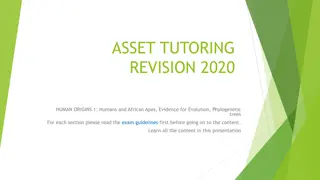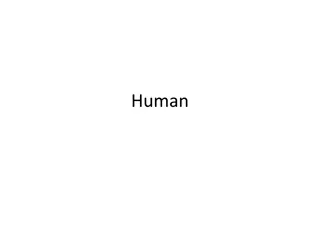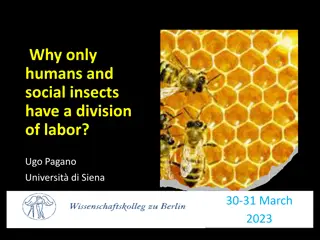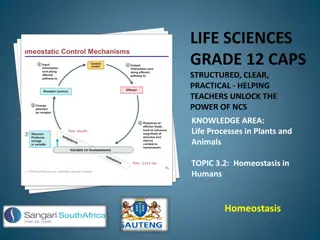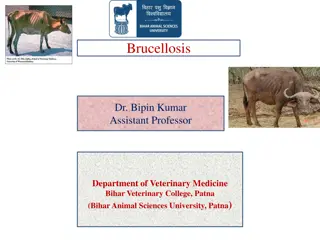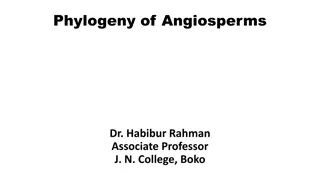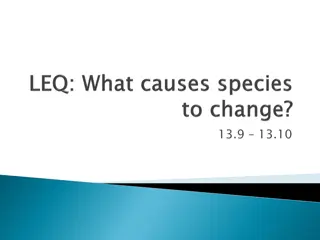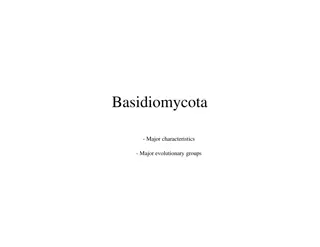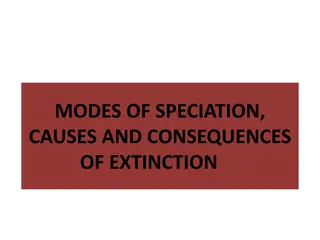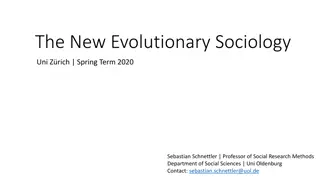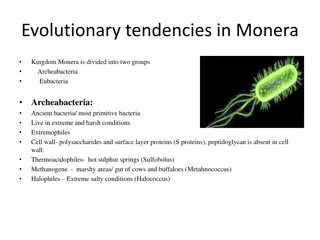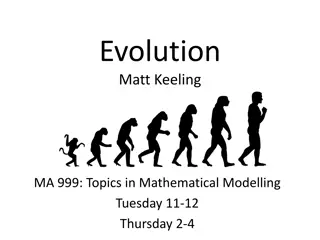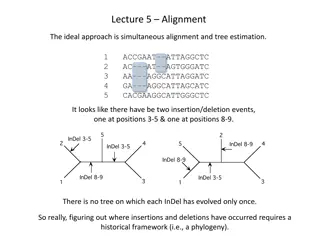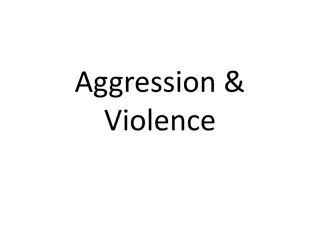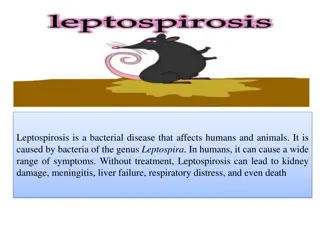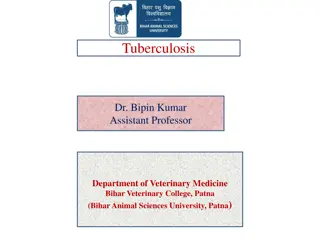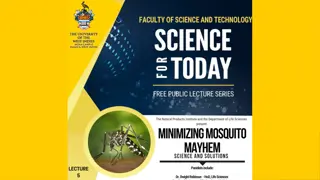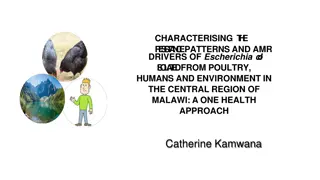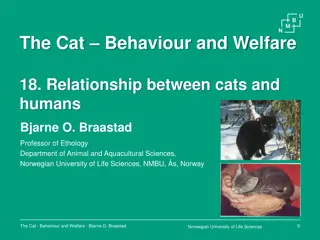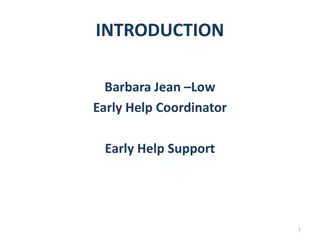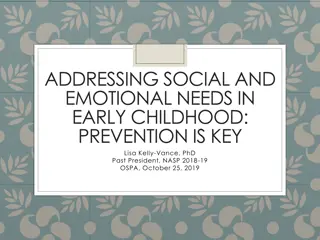Evolutionary Journey of Early Humans
Explore the evolution of early humans, from the diverse species that lived over millions of years to Darwin's Theory of Evolution. Discover how natural selection shaped human ancestors and led to the development of modern humans. Uncover the significance of Africa as the cradle of civilization and the advancements in behavior and tool usage during the Stone Age periods.
Download Presentation

Please find below an Image/Link to download the presentation.
The content on the website is provided AS IS for your information and personal use only. It may not be sold, licensed, or shared on other websites without obtaining consent from the author. Download presentation by click this link. If you encounter any issues during the download, it is possible that the publisher has removed the file from their server.
E N D
Presentation Transcript
Year 7 Hist Early Humans Readings
fitness in its environment. Species alive today descended with modification from species that Many different human-like species existed over the 4-8 million years since our lineage split lived in the past. All organisms on earth are united into a single family tree of life by common ____________________________________________________________________ 1. Write down the heading. ________________________________________________ Some of these species would have lived at the same time, and not all of them are the ____________________________________________________________________ ____________________________________________________________________ A scientific theory is a well-supported testable explanation of phenomena that has occurred a. ___________________________________________________________________ b. ___________________________________________________________________ c. ___________________________________________________________________ Each species has to compete for food, shelter and other life necessities. Individuals better humans. There are many different ideas, and as new fossils are discovered the gaps Lesson 1 Year 7 Hist - Early Humans - Darwin s Theory of Evolution Reading Activity Evolution, or change over time, is the process by which modern organisms have descended ___________________________________________________________________ suited for the environment survive and reproduce. Over time, natural selection results in 3. Circle the metalanguage words : ancestors, compete, descended, environment, fossils, We don t know the exact progression from species to species that led to modern changes in inherited characteristics of a population. These changes increase a species 4. Write down the words you don t know the meaning of or find difficult to spell. 1. In your own words answer What is Darwin s theory of evolution? 7. Write down 3 things you have learnt from reading this passage. from apes collectively, we call these species hominids. become filled and the picture becomes clearer. inherited, progression, selection, well-supported direct ancestors of modern humans. Evolution by Natural Selection Darwin s Theory of Evolution 2. Number the paragraphs. from ancient organisms. 6. Highlight 5 verbs. 5. Highlight 5 nouns. in the natural world. descent
During the Middle and Later Stone Age periods a much wider and versatile range According to the 'out of Africa' theory, about 60 000 years ago modern humans Africa can be seen as representing the cradle of civilization, the continent from of tools were developed. Behaviour became much more complex and there were a far greater million years ago and that evidence of the use of stone tool can be dated to 1 and half million evolution prior to our upright ancestors detaching themselves from the rest of the primates Organised activities and institutions developed, such as manufacture and trade, a. ___________________________________________________________________ b. ___________________________________________________________________ c. ___________________________________________________________________ Some groups eventually settled down to grow crops and domesticate animals. In This breakaway group began to walk upright which enabled them to see further the Stone Age and this period continued even after the first known migration out of Africa. 1. Write down the heading. ________________________________________________ people who resembled human beings as we know them today. Again it has to be stressed and threatening habitat. Also they developed the ability to carry food, tools or weapons in their As the period of the Later Stone Age drew to a close, Africa was populated by and have far better vision. As a result they became more aware of the presence of possible remembered that this evolutionary process took place over many hundreds of thousands of which man first emerged and then evolved. There had occurred 60 million years of primate Evidence has been accumulated that dates this split from other primates to 4 The introduction of stone tools marks the beginning of what is categorized as years later. Change did not occur overnight. It was an extremely slow process not like the range of cultural life styles such as the more organized hunter and gatherer, compared to ___________________________________________________________________ changes happening in today s world like climate change and population increases which are 3. Circle the metalanguage words : ancestors, civilization, evolutionary , 'out of Africa , (Homo sapiens) began to leave that continent and gradually spread throughout the world. Lesson 2 Year 7 Hist - Early Humans Historical context of the overview Reading Some of these societies became the focal points of empires which shaped some regions, villages, towns and finally cities emerged and specialised occupations and free hands and over an evolutionary period became capable of constructing basic tools. the scavenger whose approach to daily existence and survival was far less structured. predators, automatically increasing their ability to survive in a possible hostile and 4. Write down the words you don t know the meaning of or find difficult to spell. 7. Write down 3 things you have learnt from reading this passage. art and writing, religion and law, military and political structures. and taking a separate evolutionary path. occurring rapidly and before our eyes. predators , primates , Stone Age Africa The Cradle of Civilisation. various parts of the ancient world. 2. Number the paragraphs. 6. Highlight 5 verbs. 5. Highlight 5 nouns. trades developed. Activity years.
could have been over a million years ago. They do know that it ended in about 3000 B.C. when products today _______________________________________________________ learnt to bind the stone to a wooden handle using the tough sinews from legs of animals they Africa in the Kalahari Desert, Australia and New Guinea when European settlers arrived who 16.Name the country where people have only just left the Stone Age. _________________ 10.What did people who lived in caves use for thread ? ____________________________ a. ___________________________________________________________________ b. ___________________________________________________________________ c. ___________________________________________________________________ houses or shelters of any kind. They lived in caves where they were protected from the rain 17.In which desert do you think primitive people of South Africa lived ? _______________ 11. Were there Stone Age people in Australia when Cook arrived ? ___________________ 1. Write down the heading. ________________________________________________ 18.Which word means 'gathered' ? __________________________________________ What other animal besides a wolf might worry people who lived in caves ? ______________ stretched it out on the ground and scraped off the fat. They left hair on the outside. Then, 8. What is the skin of an animal with the hair left on called? _______________________ We are not certain when the Stone Age began. Scientists think it 19.Which word means 'far away or distant'? ___________________________________ with sandstone. The finished skins gave them rugs and clothes. For needles they poked thin The people of the Stone Age hunted animals which included deer, and snow. The caves were also safe places in which they could sleep without being attacked The tools these people used were made of stone, so we call those Spear-heads were made from a kind of stone called? ____________________________ after they had softened the hide by stamping on it or chewing it, they polished the inside ___________________________________________________________________ had killed. Pieces of flint were collected and smashed with heavier rocks to make pointed times the Stone Age. A hard, sharp-edged piece of stone was an axe-head. These people were still living successfully using Stone Age technology. In remote parts of New Guinea 9. What kind of animal mentioned has been tamed and is used to produce milk and dairy flakes which were used as arrow tips. Flint stones with sharp edges were used as knives. people learnt to make things from copper and bronze. There were people living in South Many thousands of years ago, people had not learned to build wild horses, wild cattle and bison. After eating the meat, they took the animal's hide, 3. Circle the metalanguage words:. Flakes, flint, hide, protected, sinews, successfully 4. Write down the words you don t know the meaning of or find difficult to spell. Lesson 3 Year 7 Hist Early Humans Stone age life Reading Activity 12.Circle the word that describes the main idea of the first paragraph pointed bones through the skins and stitched them with fine sinews. 7. Write down 3 things you have learnt from reading this passage. some tribes have only just begun to use tools made of iron. 2. Number the paragraphs. 14.Animals attacked people 15.People lived in caves 13.People slept safely 6. Highlight 5 verbs. 5. Highlight 5 nouns. by bears or wolves. Stone age life
In comparison the Neanderthals were much taller, more ___________ and had a larger body most vulnerable from attacks by large and ferocious carnivores. Large stones may have been gathered Their home base provided the nucleus of their communal existence. Individuals left this years ago and the Homo sapiens were better adapted and __________ to survive, whilst the wood. Both species used pressure flaking; a _____________used to sharpen the ________ a. ___________________________________________________________________ b. ___________________________________________________________________ c. ___________________________________________________________________ stones at many of these sites and believed that could have been placed there for defensive purposes. 1. Write down the heading. ________________________________________________ hunters. Group co-operation would have been vital to successfully hunt and this could have led to the and stockpiled around their cave dwellings as a means of protection. Professor Leakey found piles of interbred with each other to result in the many varied forms of our race which exist today. secure base in search of wild game and food which was bought back to camp and shared out amongst usually would keep to an area within 40 kilometres of their home base. Gender determined individual Night time was the most dangerous part of the day. This was when they were at their mass than Homo sapiens. Both species made _____________ tools from stone, _____ and been gathered locally while the remainder of their diet was supplemented through hunting. Hunters Through the slow process of evolutionary development and the increasing widespread roles with in the communal group. Hunting was seen as an all male activity. Women and young people _____________ and hunter gatherer talents most probably led to their ____________. slaughter of larger and more powerful animals could not have been achieved regularly by individual With the onset of the hunting season adult males would spend much more time away It is thought that 75% of early man s diet was plant based. These plants would have use of basic tools, man developed the skills and ability to catch and eat meat. Tools enabled these The _____________ are the most _________ species to Homo sapiens, of ___________________________________________________________________ which modern humans have _________. There are many theories which suggest they are the rest of the clan. Female members of the group it is thought developed strong bonds with the But the most widely accepted ________ is both species lived side by side __________ of tools. But it was the Homo sapiens who developed far more ___________methods of Bone, ancestors, edges, extinct, 40 000, Neanderthals, sophisticated, similar, evolved, completely separate species, or Neanderthals are Homo sapiens ___________, or they from these settlements. More structured hunting groups might have evolved as the hunting and hunter/gatherer groups to plan out and exert more control over their everyday existence. 3. Write down the words you don t know the meaning of or find difficult to spell. Overall the success of the Homo sapiens and the evidence of their developed Lesson 4 Year 7 Hist - Early humans Stone age life Reading Activity theory, survival, competed muscular, technique, intricate , culture tended to gather food locally and maintain and look after the home base. 6. Write down 3 things you have learnt from reading this passage. young but the existing social structures in place were non monogamous. workmanship, which led to their successful survival. formation of more structured hunting groups. The Neanderthals and Homo sapiens Neanderthals became ___________. 2. Number the paragraphs. 5. Highlight 5 verbs. 4. Highlight 5 nouns. Stone age life
3. Circle the metalanguage words : agriculture, cloth, development, foraged, metals, millions, metals to make better tools, at first from bronze and later from iron. During the Palaeolithic Advances toward greater cultural complexity, which began to appear when Homo ______________________________________________________________________ Palaeolithic period extended until around 10 000 years ago and was followed by the Neolithic period, which accompanied the development of agriculture. Early humans shaped weapons for Hunting, gathering, and fishing continue but settlements become bigger in some animals and managing the landscape, in places ranging from Africa to Australia. Early humans a. ___________________________________________________________________ b. ___________________________________________________________________ c. ___________________________________________________________________ ___________________________________________________________________ 1. Write down the heading. ________________________________________________ wore animal skins for warmth, and there is evidence of weaving fibres into cloth as early as 9. What does Neolithic mean? _____________________________________________ 10.What does lithic mean? ________________________________________________ period, people were hunter-gatherers. They foraged for wild fruits, nuts, roots and grains, 8. What does Paleolithic mean? ____________________________________________ hunting animals and tools for cutting, scraping, digging and grinding. Humans learnt to use ___________________________________________________________________ seasons changed. We are slowly learning about the early human use of fire, for hunting and hunted animals. They lived as nomads, and followed food from place to place as the For millions of years, tools were made from stone as well as bones. The 4. Write down the words you don t know the meaning of or find difficult to spell. 11. What was the major change that divided Paleolithic and Neolithic societies? Humans in many parts of the world continue to gather and hunt. Year 7 Hist - Early Civilisations Lesson 1 Introduction Reading Activity Early era of farming to beginnings of city-based societies. More and better tools, symbolic thought and expression. Hunting, gathering, and fishing the universal way of life. Paleolithic Age = Old Stone Age = 2 million years - 10,000 years ago 7. Write down 3 things you have learnt from reading this passage. Beginnings of tool-making to beginnings of farming. Late Paleolithic = 200,000 - 10,000 years ago Neolithic Age = 10,000 - 4,000 years ago Paleo = Old, Lithic = Stone. Neo = New, Lithic = Stone. More complex stone tools. sapiens still lived only in Africa. 2. Number the paragraphs. nomads, tools, weapons, 6. Highlight 5 verbs. 5. Highlight 5 nouns. 26 000 years ago. The Stone Ages places.
This Neolithic revolution was soon followed by the invention of writing which also 3. Circle the metalanguage words : communities, construction, cultivate, developed, invention, ______________________________________________________________________ 17. Why do you think these developments led to cities? ____________________________ ______________________________________________________________________ ______________________________________________________________________ ______________________________________________________________________ ______________________________________________________________________ ______________________________________________________________________ 15. Why was the invention of ceramics and basket weaving important?__________________ 13.Why do you think they were domesticated before cattle and pigs?__________________ of food sources. Einkorn, rye, bread wheat, and lentils were the first plants to be cultivated, 12.Which animals were domesticated first?_____________________________________ 14. What are ceramics?____________________________________________________ a. ___________________________________________________________________ b. ___________________________________________________________________ c. ___________________________________________________________________ ___________________________________________________________________ 10.Why did man begin to cultivate plants?______________________________________ these changes came the construction of more permanent settlements and a sense of clearer boundaries of individual and group territorial space. People began to live in larger groups and 16. Why were early settlements near water?____________________________________ foods and liquids as well as to carry and transport them over larger distances. Probably with 11. What does domesticate mean?____________________________________________ 1. Write down the heading. ________________________________________________ 9. What were the first plants to be cultivated by man? ___________________________ more permanent communal settlements as close as possible to fresh water supplies in order quantity of wild plants available. People began to cultivate plants to increase the availability were domesticated about 1000 years later. Mankind was no longer limited to small bands of Middle East. Sheep and goats were domesticated first (around 6,500 BCE). Cattle and pigs The invention of basket making and ceramics enabled communities to store ___________________________________________________________________ people wandering in the wilderness, searching for food and water in order to sustain life. Agriculture first developed north and east of the Fertile Crescent, between 11,000 and 9,500 BCE. A cold, dry period called the Younger Dryas Event led to a decrease in the The domestication of animals followed the domestication of plants in the 4. Write down the words you don t know the meaning of or find difficult to spell. Year 7 Hist - Early Civilisations Lesson 2 Agriculture Reading Activity 7. Write down 3 things you have learnt from reading this passage. revolutionized the way that we perceived ourselves and others. to feed himself, his livestock and water his crops. followed by other forms of wheat and barley. limited, permanent, sustain, wandering 8. What does cultivate mean? Development of Settlements 2. Number the paragraphs. 6. Highlight 5 verbs. 5. Highlight 5 nouns.
These places where people began to _______________ down, grow crops, and start villages time to devote to the development of new_____________________________________ . a. ___________________________________________________________________ b. ___________________________________________________________________ c. ___________________________________________________________________ 1. Write down the heading. ________________________________________________ _____________________________________________________________________ With the advent of farming and ______________________animals to feed a society, life culture, common laws, a common economy, and typically a common ____________or religion. As agriculture spread different areas began to grow different _____________ that were Most of these areas were in___________________ valleys. This first was Mesopotamia Other river valleys include _______________________ in Egypt, the Indus in India, and ____________________________________________________________________ ____________________________________________________________________ _____________________________ the difficulties of life. The population quickly rose With an abundance of _______________and more permanent shelters, people had more ___________________ aided humans greatly in transporting goods from one location to As mankind began to develop more complex ways of life, and as cities began to increase in ___________________________________________________________________ ___________________________________________________________________ __________________________________________________________________ size and complexity, a new type of society emerged. These societies are known today as another. The loom allowed people to weave cloth and create finer and more comfortable 7. Where did the first civilisations arise? __________________________________ _______________________. A civilization is a nation or people that share a common Crops, civilizations, Domesticated, faith, food, oldest, river, settle, survived, 3. Write down the words you don t know the meaning of or find difficult to spell. from around 2 million humans on the Earth to more than ___________million. Year 7 Hist - Early Civilisations Lesson 3 First Cities Reading Activity Better farming equipment, such as the ox-driven plow, were invented. The The _____________ and largest of the villages are found in SW Asia. became much easier for early humans. As a result, many more humans These villages spread throughout Europe and the rest of the world. 6. Write down 3 things you have learnt from reading this passage. 8. What were the new inventions that helped people? between the Tigris and Euphrates River Valleys. 9. What common features did civilisations have? became known as the Cradles of Civilization. technologies, The Nile, wheel, 90 Technologies Advance Quickly suited to their environment. 2. Number the paragraphs. Variations on Agriculture the Huang He in China. Development of cities 5. Highlight 5 verbs. 4. Highlight 5 nouns. clothing.
a. ___________________________________________________________________ b. ___________________________________________________________________ c. ___________________________________________________________________ 1. Write down the heading. ________________________________________________ ___________________________________________________________________ By 3000 B.C., Sumer had at least 12 city-states most, like Ur, were on fertile land by mouths of 3. Circle the metalanguage words : irrigation, society. surplus, temple, wealth, worshiped 4. Write down the words you don t know the meaning of or find difficult to spell. Year 7 Hist - Early Civilisation Lesson 4 First Cities Reading Activity 7. Write down 3 things you have learnt from reading this passage. Sumerian religion based on polytheism belief in many gods, goddesses This type of ruler became a king the highest-ranked leader of group City-state self-ruled community including city and nearby farmlands Homes had thick mud walls to keep out heat, tunnels to get fresh air By 3000 B.C., rich city-states were attacked by other regions, cities Believed souls of dead went to land of no return gloomy underworld Priests still tried to please gods people thought gods let kings rule - Scholars think hard life made Sumerians expect unhappy afterlife Sumerians thought gods protected against fl ood, drought, invasion Saw gods as rich landowners who created humans to work for them In times of war, people asked powerful men to rule, protect cities In Sumerian city, largest, most important building was the temple - gods of sky, wind, foothills, fresh water created and ruled world - people believed claim and accepted priest as the cities leaders Cities were centers of society, but most people lived in country - priests were paid with grain, so they controlled, stored surplus - later they ran city-states full-time, took some of priests jobs People followed religious rules, prayed, made offerings to gods - all participated in rituals, many of which were held at ziggurat rooms surrounded covered courtyard that was cooking area - priests ended up controlling much of city- states wealth Slow-growing Sumerian cities had narrow, winding streets - ziggurats Sumerian temples first built around 2200 B.C. By 2375 B.C., Sumer was a kingdom ruled by a single king Priests ran irrigation, so ziggurat was center of city life Priests worked to please gods in order to protect cities Walls surrounded cities; gates let people come and go - priests claimed that they had infl uence with gods - cities began to rule surrounding lands, villages Believed gods looked and acted like people - Sumerians had thousands of lesser gods Each city-state worshiped own god SUMER: The First civilisation 2. Number the paragraphs. The City-States of Sumer The Ziggurat: City Center Priests Become Leaders New Leaders in Sumer 6. Highlight 5 verbs. 5. Highlight 5 nouns. Service to the Gods Sumerian Religion Tigris, Euphrates Life in the City
To help you prepare for this you are to complete the following 5.Write out your Persuasive writing task using the Persuasive You will be required to complete a persuasive writing task on writing scaffold and XXXTC scaffolding for each paragraph. Year 7 Hist: Early civilisations Lesson 5 Persuasive writing 6. Now use memory mnemonics to remember your paragraph Development of agriculture and domestication of animals 3. Under the following headings group the words you have All Ancient Civilisations had the same characteristics. 2. Beside each letter write words that relate to the written. You may add more words if you like. 4. Each heading is the topic of a paragraph. Work out the order of your paragraphs 1. Write the alphabet down your page. Development of social structure characteristics of a civilisations. The importance of a river Development of religion Specialisation of labour Development of writing Advanced technology Development of laws the statement : headings steps





